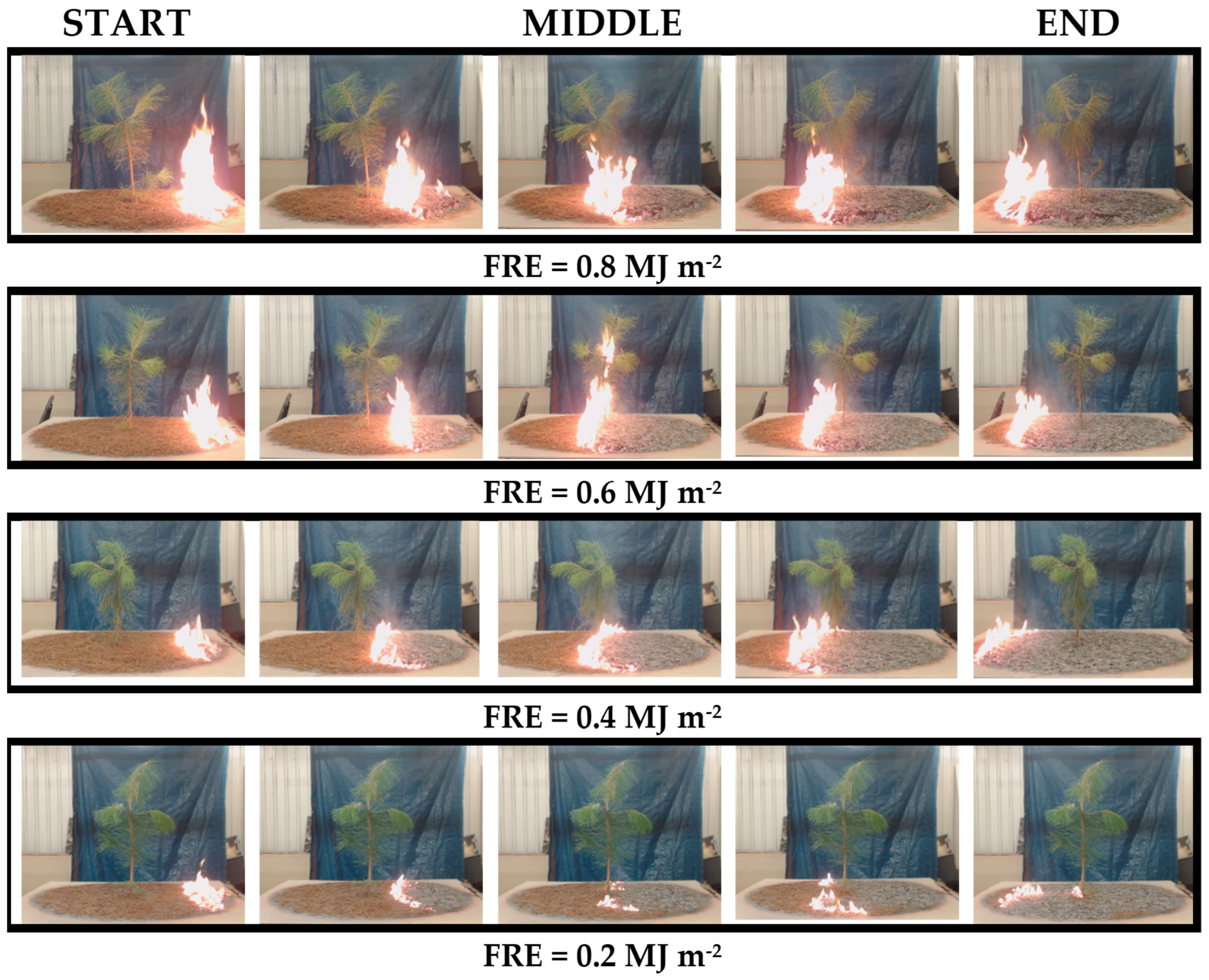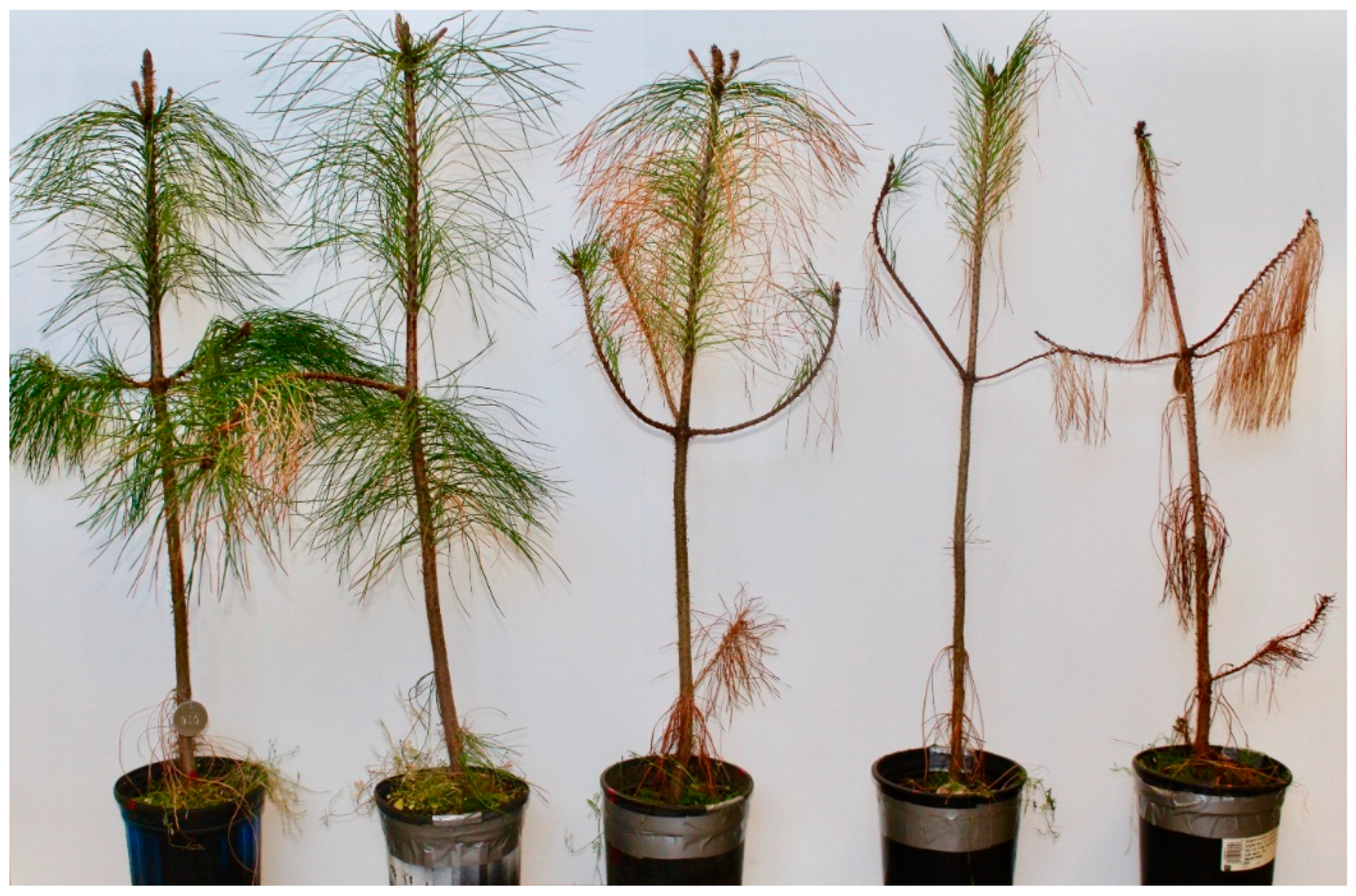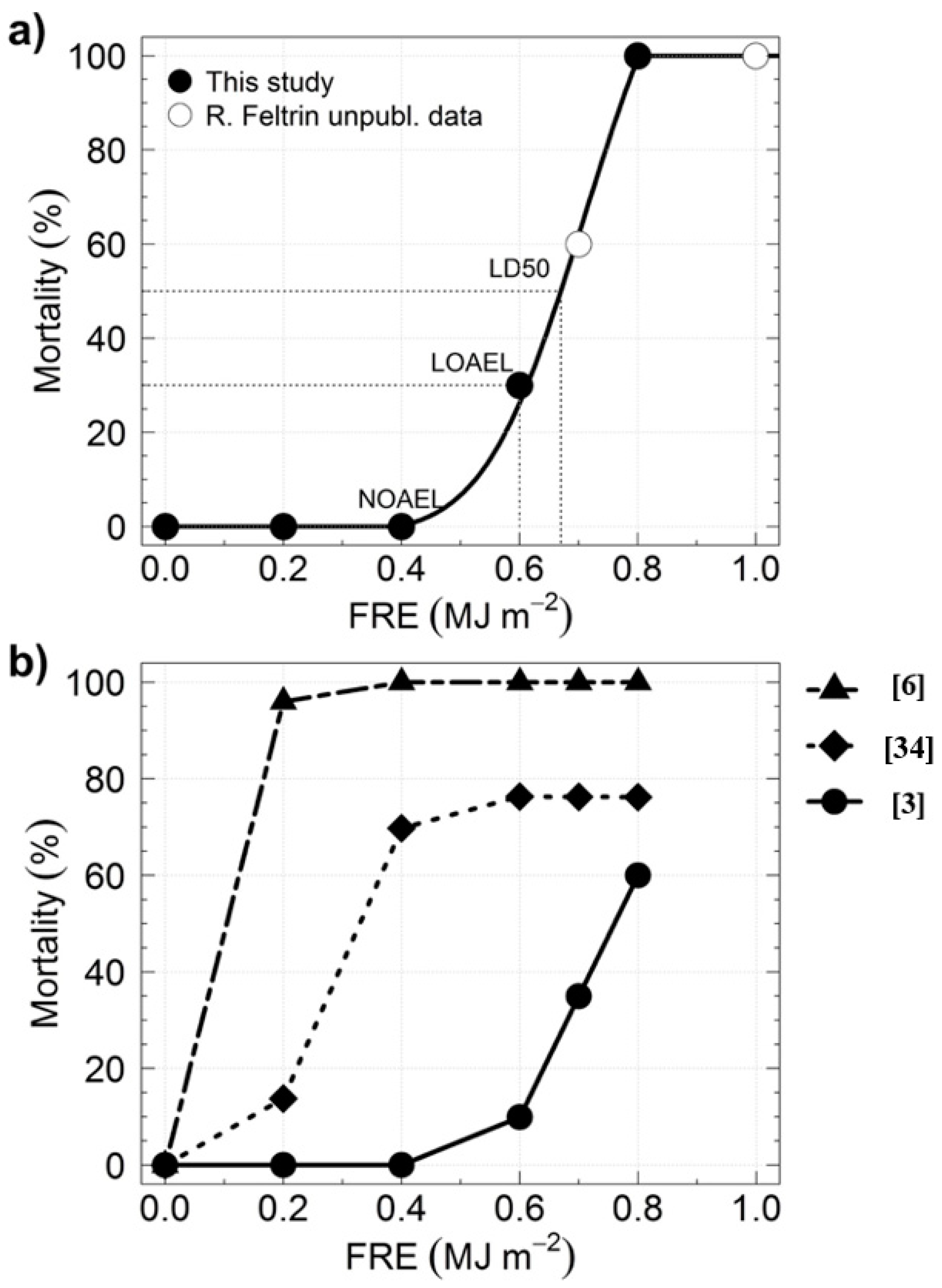The Survival of Pinus ponderosa Saplings Subjected to Increasing Levels of Fire Behavior and Impacts on Post-Fire Growth
Abstract
1. Introduction
- (1)
- H1: Increased FRE (dose) results in increased mortality (response) in Pinus ponderosa saplings up to several months post-fire.
- (2)
- H2: Increased FRE (dose) leads to decreased rate of growth (height and stem diameter) (response) of surviving Pinus ponderosa saplings up to several months post-fire.
- (3)
- H3: The dose-response relationships observed for Pinus ponderosa saplings are comparable to those observed for Pinus contorta [4].
- (4)
- H4: As hypothesized by [4], the dose-response relationships observed for Pinus ponderosa saplings during laboratory fires will exhibit a higher probability of mortality at lower dose levels as compared to similar age/size saplings burned during field experiments.
2. Materials and Methods
2.1. Trees
2.2. Experimental Design and Fire Experiments
2.3. Sapling Measurements
2.4. Comparison with Logistic Regression Models
2.5. Data Analysis
3. Results
4. Discussion
5. Conclusions
- (1)
- H1: Increased FRE (dose) leads to increased mortality (response) in Pinus ponderosa saplings up to several months post-fire.
- (2)
- H2: Increased FRE (dose) leads to reduced growth (response) of surviving Pinus ponderosa saplings up to several months post-fire.
- (3)
- H3: The dose-response relationships observed for Pinus ponderosa saplings are comparable to those observed for Pinus contorta [4].
- (4)
- H4: As hypothesized by [4], the dose-response relationships observed for Pinus ponderosa saplings during laboratory fires will exhibit a higher probability of mortality at lower dose levels as compared to similar age/size saplings burnt during field experiments.
Author Contributions
Funding
Conflicts of Interest
References
- Schoennagel, T.; Balch, J.K.; Brenkert-Smith, H.; Dennison, P.E.; Harvey, B.J.; Krawchuk, M.A.; Mietkiewicz, N.; Morgan, P.; Moritz, M.A.; Rasker, R.; et al. Adapt to more wildfire in western North American forests as climate changes. Proc. Natl. Acad. Sci. USA 2017, 114, 4582–4590. [Google Scholar] [CrossRef] [PubMed]
- Smith, A.M.S.; Kolden, C.A.; Bowman, D.M.J.S. Biomimicry can help humans to sustainably coexist with fire. Nat. Ecol. Evol. 2018, 2, 1827–1829. [Google Scholar] [CrossRef]
- Battaglia, M.; Smith, F.W.; Sheppard, W.D. Predicting mortality of ponderosa pine regeneration after prescribed fire in the Black Hills, South Dakota, USA. Int. J. Wildland Fire 2009, 18, 176–190. [Google Scholar] [CrossRef]
- Smith, A.M.S.; Talhelm, A.F.; Johnson, D.M.; Sparks, A.M.; Yedinak, K.M.; Apostol, K.G.; Tinkham, W.T.; Kolden, C.A.; Abatzoglou, J.T.; Lutz, J.A.; et al. Effects of fire radiative energy density doses on Pinus contorta and Larix occidentalis seedling physiology and mortality. Int. J. Wildland Fire 2017, 26, 82–94. [Google Scholar] [CrossRef]
- Hood, S.M.; Varner, J.M.; van Mantgem, P.; Cansler, C.A. Fire and tree death: Understanding and improving modeling of fire induced tree mortality. Environ. Res. Lett. 2018, 13, 113004. [Google Scholar] [CrossRef]
- Rebain, S. The Fire and Fuels Extension to the Forest Vegetation Simulator: Updated Model Documentation; Internal Rep.; U.S. Department of Agriculture, Forest Service, Forest Management Service Center: Fort Collins, CO, USA, 2015; 403p.
- Smith, A.M.S.; Sparks, A.M.; Kolden, C.A.; Abatzoglou, J.T.; Talhelm, A.F.; Johnson, D.M.; Boschetti, L.; Lutz, J.A.; Apostol, K.G.; Yedinak, K.M.; et al. Towards a new paradigm in fire severity research using dose-response experiments. Int. J. Wildland Fire 2016, 25, 158–166. [Google Scholar] [CrossRef]
- Sparks, A.M.; Kolden, C.A.; Talhelm, A.F.; Smith, A.M.S.; Apostol, K.G.; Johnson, D.M.; Boschetti, L. Spectral indices accurately quantify changes in tree physiology following fire: Toward mechanistic assessments of landscape post-fire carbon cycling. Remote Sens. 2016, 8, 572. [Google Scholar] [CrossRef]
- Sparks, A.M.; Smith, A.M.S.; Talhelm, A.F.; Kolden, C.A.; Yedinak, K.M.; Johnson, D.M. Impacts of fire radiative flux on mature Pinus ponderosa growth and vulnerability to secondary mortality agents. Int. J. Wildland Fire 2017, 26, 95–106. [Google Scholar] [CrossRef]
- Sparks, A.M.; Kolden, C.A.; Smith, A.M.S.; Boschetti, L.; Johnson, D.M.; Cochrane, M.A. Fire intensity impacts on post-fire response of temperate coniferous forest net primary productivity. Biogeosciences 2018, 15, 1173–1183. [Google Scholar] [CrossRef]
- Sparks, A.M.; Talhelm, A.F.; Feltrin, R.P.; Smith, A.M.S.; Johnson, D.M.; Kolden, C.A.; Boschetti, L. An experimental assessment of the impact of drought and fire on western larch mortality and recovery. Int. J. Wildland Fire 2018, 27, 490–497. [Google Scholar] [CrossRef]
- Battaglia, M.; Smith, F.W.; Sheppard, W.D. Can prescribed fire be used to maintain fuel treatment effectiveness over time in Black Hills ponderosa pine forests? For. Ecol. Manag. 2008, 256, 2029–2038. [Google Scholar] [CrossRef]
- Lentile, L.B.; Holden, Z.; Smith, A.M.S.; Falkowski, M.J.; Hudak, A.T.; Morgan, P.; Lewis, S.A.; Gessler, P.E.; Benson, N.C. Remote sensing techniques to assess active fire and post-fire effects. Int. J. Wildland Fire 2006, 15, 319–345. [Google Scholar] [CrossRef]
- Roy, D.P.; Boschetti, L.; Trigg, S.N. Remote sensing of fire severity: Assessing the performance of the normalized burn ratio. IEEE Geosci. Remote Sens. Lett. 2006, 3, 112–116. [Google Scholar] [CrossRef]
- Lentile, L.B.; Morgan, P.; Hudak, A.T.; Bobbitt, M.J.; Lewis, S.A.; Smith, A.M.S.; Robichaud, P.R. Post-fire burn severity and vegetation response following eight large wildfires across the western US. Fire Ecol. 2007, 3, 91–108. [Google Scholar] [CrossRef]
- Lentile, L.B.; Smith, A.M.S.; Hudak, A.T.; Morgan, P.; Bobbitt, M.; Lewis, S.A.; Robichaud, P. Remote sensing for prediction of 1-year post-fire ecosystem condition. Int. J. Wildland Fire 2009, 18, 594–608. [Google Scholar] [CrossRef]
- Hudak, A.T.; Morgan, P.; Bobbitt, M.J.; Smith, A.M.S.; Lewis, S.A.; Lentile, L.B.; Robichaud, P.R.; Clark, J.T.; McKinley, R.A. The relationship of multispectral satellite imagery to immediate fire effects. Fire Ecol. 2007, 3, 64–90. [Google Scholar] [CrossRef]
- Kolden, C.A.; Smith, A.M.S.; Abatzoglou, J.T. Limitations and utilization of Monitoring Trends in Burn Severity products for assessing wildfire severity in the USA. Int. J. Wildland Fire 2015, 24, 1023–1028. [Google Scholar] [CrossRef]
- McCarley, T.R.; Smith, A.M.S.; Kolden, C.A.; Kreitler, J. Evaluating the mid-infrared bi-spectral index for assessing severity and area burned in a conifer forest. Int. J. Wildland Fire 2018, 27, 407–412. [Google Scholar] [CrossRef]
- McCarley, T.R.; Kolden, C.A.; Vaillant, N.M.; Hudak, A.T.; Smith, A.M.S.; Wing, B.M.; Kellogg, B.; Kreitler, J. Multi-temporal LiDAR and Landsat quantification of fire induced changes to forest structure. Remote Sens. Environ. 2017, 191, 419–432. [Google Scholar] [CrossRef]
- Jolly, W.M.; Johnson, D.M. Pyro-Ecophysiology: Shifting the Paradigm of Live Wildland Fuel Research. Fire 2018, 1, 8. [Google Scholar] [CrossRef]
- Huddle, J.A.; Pallardy, S.G. Effects of soil and stem base heating on survival, resprouting and gas exchange of Acer and Quercus seedlings. Tree Physiol. 1996, 16, 583–589. [Google Scholar] [CrossRef]
- Furniss, T.J.; Larson, A.J.; Kane, V.R.; Lutz, J.A. Multi-scale assessment of post-fire tree mortality models. Int. J. Wildland Fire 2019, 28, 46–61. [Google Scholar] [CrossRef]
- Ryan, K.C.; Reinhardt, E.D. Predicting postfire mortality of seven western conifers. Can. J. For. Res 1988, 18, 1291–1297. [Google Scholar] [CrossRef]
- Kobziar, L.; Moghaddas, J.; Stephens, S.L. Tree mortality patterns following prescribed fires in a mixed conifer forest. Can. J. For. Res. 2006, 36, 3222–3238. [Google Scholar] [CrossRef][Green Version]
- Woolley, T.; Shaw, D.C.; Ganio, L.M.; Fitzgerald, S. A review of logistic regression models used to predict post-fire tree mortality of western North American conifers. Int. J. Wildland Fire 2012, 21, 1–35. [Google Scholar] [CrossRef]
- Hood, S.M.; McHugh, C.W.; Ryan, K.C.; Reinhardt, E.; Smith, S.L. Evaluation of a post-fire tree mortality model for western USA conifers. Int. J. Wildland Fire 2007, 16, 679–689. [Google Scholar] [CrossRef]
- Lutes, D. FOFEM 6.5 First Order Fire Effects Model User Guide, Fire and Aviation Management. Rocky Mountain Research Station Fire Modelling Institute, United States Department of Agriculture, 2018. Available online: https://www.firelab.org/document/fofem-files (accessed on 19 March 2019).
- Dietrich, J.H. Recovery Potential of Fire-Damaged Southwestern Ponderosa Pine. Rocky Mountain Forest and Range Experiment Station; Research Note—379; U.S. Department of Agriculture, Forest Service: Ogden, UT, USA, 1979.
- Dumroese, D.S.; Abbott, A.M.; Rice, T.M. Forest Soil Disturbance Monitoring Protocol-II; Gen. Tech. Rep. WO-GTR-82b; U.S. Department of Agriculture, Forest Service: Washington, DC, USA, 2009; 64p.
- Smith, A.M.S.; Tinkham, W.T.; Roy, D.P.; Boschetti, L.; Kumar, S.; Sparks, A.M.; Kremens, R.L.; Falkowski, M.J. Quantification of fuel moisture effects on biomass consumed derived from fire radiative energy retrievals. Geophys. Res. Lett. 2013, 40, 6298–6302. [Google Scholar] [CrossRef]
- Matthews, S. Effect of drying temperature on fuel moisture content measurements. Int. J. Wildland Fire 2010, 19, 800–802. [Google Scholar] [CrossRef]
- Mercker, D.C.; Buckley, D.S.; Conn, J.P. Effects of prolonged storage on survival and growth of outplanted bottomland oaks. In Proceedings of the 17th Central Hardwood Forest Conference, Lexington, KY, USA, 5–7 April 2010; Gen. Tech. Rep. NRS-P-78. Fei, S., Lhotka, J.M., Stringer, J.W., Gottschalk, K.W., Miller, G.W., Eds.; U.S. Department of Agriculture, Forest Service, Northern Research Station: Newtown Square, PA, USA, 2011; pp. 341–346. [Google Scholar]
- Hood, S.; Lutes, D. Predicting post-fire tree mortality for 12 western US conifers using the first order fire effects model (FOFEM). Fire Ecol. 2017, 13, 66–84. [Google Scholar] [CrossRef]
- Peterson, D.L. and Ryan, K.C. Modeling Postfire Conifer Mortality for Long-range Planning. Environ. Manag. 1986, 10, 797–808. [Google Scholar] [CrossRef]
- Brown, J.K.; DeByle, N.V. Fire damage, mortality, and suckering in aspen. Can. J. For. Res. 1987, 17, 1100–1109. [Google Scholar] [CrossRef]
- Keyser, T.L.; McDaniel, V.L.; Klein, R.N.; Drees, D.G.; Burton, J.A.; Forder, M.M. Short-term stem mortality of 10 deciduous broadleaved species following prescribed burning in upland forests of the Southern US. Int. J. Wildland Fire 2018, 27, 42–51. [Google Scholar] [CrossRef]
- Harrington, M.G. Ponderosa pine mortality from spring, summer, and fall crown scorching. West. J. Appl. For. 1987, 2, 14–16. [Google Scholar]
- Harrington, M.G. Predicting Pinus ponderosa mortality from dormant season and growing-season fire injury. Int. J. Wildland Fire 1993, 3, 65–72. [Google Scholar] [CrossRef]
- McDowell, N.G.; Michaletz, S.T.; Bennett, K.E.; Solander, K.C.; Xu, C.; Maxwell, R.M.; Middleton, R.S. Predicting chronic climate-driven disturbances and their mitigation. Trends Ecol. Evol. 2018, 33, 15–27. [Google Scholar] [CrossRef]
- Ottmar, R.D.; Burns, M.F.; Hall, J.N.; Hanson, A.D. CONSUME: Users Guide; Gen. Tech. Rep. PNW-GTR-304; U.S. Department of Agriculture, Forest Service, Pacific Northwest Research Station: Portland, OR, USA, 1993; pp. 1–133.
- Finney, M.A. FARSITE: Fire Area Simulator—Model Development and Evaluation; Gen. Tech. Rep. RMRS-RP-4; U.S. Department of Agriculture, Forest Service, Rocky Mountain Research Station: Ogdon, UT, USA, 2004; pp. 1–47.
- Kremens, R.; Smith, A.M.S.; Dickinson, M. Fire Metrology: Current and future directions in physics-based measurements. Fire Ecol. 2010, 6, 13–35. [Google Scholar] [CrossRef]
- Wooster, M.J.; Roberts, G.; Perry, G.L.W.; Kaufman, Y.J. Retrieval of biomass combustion rates and totals from fire radiative power observations: FRP derivation and calibration relationships between biomass consumption and fire radiative energy release. J. Geophys. Res. 2005, 110, 1–24. [Google Scholar] [CrossRef]
- Roberts, G.; Wooster, M.J.; Perry, G.L.W.; Drake, N.; Rebelo, L.M.; Dipotso, F. Retrieval of biomass combustion rates and totals from fire radiative power observations: Application to southern Africa using geostationary SEVIRI imagery. J. Geophys. Res. 2005, 110, 1–19. [Google Scholar] [CrossRef]
- Fitzgerald, S. Fire ecology of ponderosa pine and the rebuilding of fire-resilient ponderosa pine ecosystems. In Proceedings of the Symposium on Ponderosa Pine: Issues, Trends, and Management, Klamath Falls, OR, USA, 18–21 October 2004; Gen. Tech. Rep PSW-GTR-198. Ritchie, M.W., Maguire, D.A., Youngblood, A., Eds.; U.S. Department of Agriculture, Forest Service, Pacific Southwest Research Station: Albany, CA, USA, 2004; pp. 197–228. [Google Scholar]
- Dickinson, M.B.; Butler, B.W.; Hudak, A.T.; Bright, B.C.; Kremens, R.L.; Klauberg, C. Inferring energy incident on sensors in low-intensity surface fires from remotely sensed radiation and using it to predict tree stem injury. Int. J. Wildland Fire 2019, 28, 230–236. [Google Scholar] [CrossRef]
- Smith, A.M.S.; Kolden, C.A.; Tinkham, W.T.; Talhelm, A.; Marshall, J.D.; Hudak, A.T.; Boschetti, L.; Falkowski, M.J.; Greenberg, J.A.; Anderson, J.W.; et al. Remote Sensing the Vulnerability of Vegetation in Natural Terrestrial Ecosystems. Remote Sens. Environ. 2014, 154, 322–337. [Google Scholar] [CrossRef]
- Bowman, D.M.J.S.; Williamson, G.; Kolden, C.A.; Abatzoglou, J.T.; Cochrane, M.A.; Smith, A.M.S. Human exposure and sensitivity to globally extreme wildfire events. Nat. Ecol. Evol. 2017, 1, 0058. [Google Scholar] [CrossRef] [PubMed]




© 2019 by the authors. Licensee MDPI, Basel, Switzerland. This article is an open access article distributed under the terms and conditions of the Creative Commons Attribution (CC BY) license (http://creativecommons.org/licenses/by/4.0/).
Share and Cite
Steady, W.D.; Partelli Feltrin, R.; Johnson, D.M.; Sparks, A.M.; Kolden, C.A.; Talhelm, A.F.; Lutz, J.A.; Boschetti, L.; Hudak, A.T.; Nelson, A.S.; et al. The Survival of Pinus ponderosa Saplings Subjected to Increasing Levels of Fire Behavior and Impacts on Post-Fire Growth. Fire 2019, 2, 23. https://doi.org/10.3390/fire2020023
Steady WD, Partelli Feltrin R, Johnson DM, Sparks AM, Kolden CA, Talhelm AF, Lutz JA, Boschetti L, Hudak AT, Nelson AS, et al. The Survival of Pinus ponderosa Saplings Subjected to Increasing Levels of Fire Behavior and Impacts on Post-Fire Growth. Fire. 2019; 2(2):23. https://doi.org/10.3390/fire2020023
Chicago/Turabian StyleSteady, Wade D., Raquel Partelli Feltrin, Daniel M. Johnson, Aaron M. Sparks, Crystal A. Kolden, Alan F. Talhelm, James A. Lutz, Luigi Boschetti, Andrew T. Hudak, Andrew S. Nelson, and et al. 2019. "The Survival of Pinus ponderosa Saplings Subjected to Increasing Levels of Fire Behavior and Impacts on Post-Fire Growth" Fire 2, no. 2: 23. https://doi.org/10.3390/fire2020023
APA StyleSteady, W. D., Partelli Feltrin, R., Johnson, D. M., Sparks, A. M., Kolden, C. A., Talhelm, A. F., Lutz, J. A., Boschetti, L., Hudak, A. T., Nelson, A. S., & Smith, A. M. S. (2019). The Survival of Pinus ponderosa Saplings Subjected to Increasing Levels of Fire Behavior and Impacts on Post-Fire Growth. Fire, 2(2), 23. https://doi.org/10.3390/fire2020023








